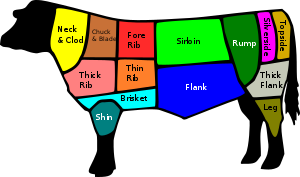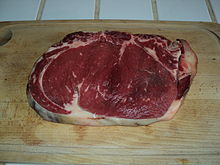| Revision as of 19:56, 24 October 2014 editMauvaisjambon (talk | contribs)1 edit →Etymology: Fixed errorTags: Mobile edit Mobile web edit← Previous edit | Revision as of 19:37, 15 November 2014 edit undoPigsonthewing (talk | contribs)Autopatrolled, Event coordinators, Extended confirmed users, Page movers, File movers, IP block exemptions, New page reviewers, Pending changes reviewers, Rollbackers, Template editors266,408 edits →top: swap infoboxNext edit → | ||
| Line 1: | Line 1: | ||
| {{ |
{{Infobox prepared food | ||
| | name |
| name = Sirloin steak | ||
| | image |
| image = BeefCutSirloin.svg | ||
| | caption = American beef cuts | |||
| | beefcut = Sirloin | |||
| | alternate_name = | |||
| | type = Beef steak | |||
| | course = | |||
| | served = | |||
| | variations = | |||
| | serving_size = 100 g | |||
| | calories = | |||
| | protein = | |||
| | fat = | |||
| | carbohydrate = | |||
| | glycemic_index = | |||
| }} | }} | ||
| {{Cuts of beef diagram|British|width=300|caption = British-tradition cuts}} | {{Cuts of beef diagram|British|width=300|caption = British-tradition cuts}} | ||
Revision as of 19:37, 15 November 2014
 American beef cuts American beef cuts | |
| Type | Beef steak |
|---|---|

The sirloin steak is a steak cut from the back of the animal.
In U.S. butchery, the steak is cut from the rear back portion of the animal, continuing off the short loin from which T-bone, porterhouse, and club steaks are cut. The sirloin is actually divided into several types of steak. The top sirloin is the most prized of these and is specifically marked for sale under that name. The bottom sirloin, which is less tender and much larger, is typically marked for sale simply as "sirloin steak". The bottom sirloin in turn connects to the sirloin tip roast.
In British and Australian butchery, the word sirloin refers to cuts of meat from the upper middle of the animal, similar to the American short loin.
Etymology
The derivation of the word "sirloin" is unclear. Some scholars point to the origin deriving from the Middle English surloine, itself derived from the Old French word surlonge, that is, sur la longe 'above the loin'. In Modern French, the cut is called aloyau or faux-filet.
However, there is anecdotal evidence that suggests the origin derives from the knighting of a loin steak by King James I of England on his return from Scotland in 1617. Scholars are divided on this issue. Some consider the knighting anecdote to be a specious coincidence of language.
Dishes
See also: List of beef dishes Sirloin steak, served with garlic butter and french fries
Sirloin steak, served with garlic butter and french fries A sirloin steak dinner
A sirloin steak dinner A raw slice of French faux-filet
A raw slice of French faux-filet
See also
References
- Dictionary.com. "Sirloin". Retrieved 16 August 2013.
- Dictionary.com. "Surloin". Retrieved 1 November 2013.
- Wordreference.com. "Sirloin". Retrieved 16 August 2013. (English-French dictionary)
- Snopes.com (8 April 2013). "Mis-Steak". Retrieved 16 August 2013.
External links
| Cuts of beef | ||
|---|---|---|
| Upper |   | |
| Lower | ||
This meat-related article is a stub. You can help Misplaced Pages by expanding it. |